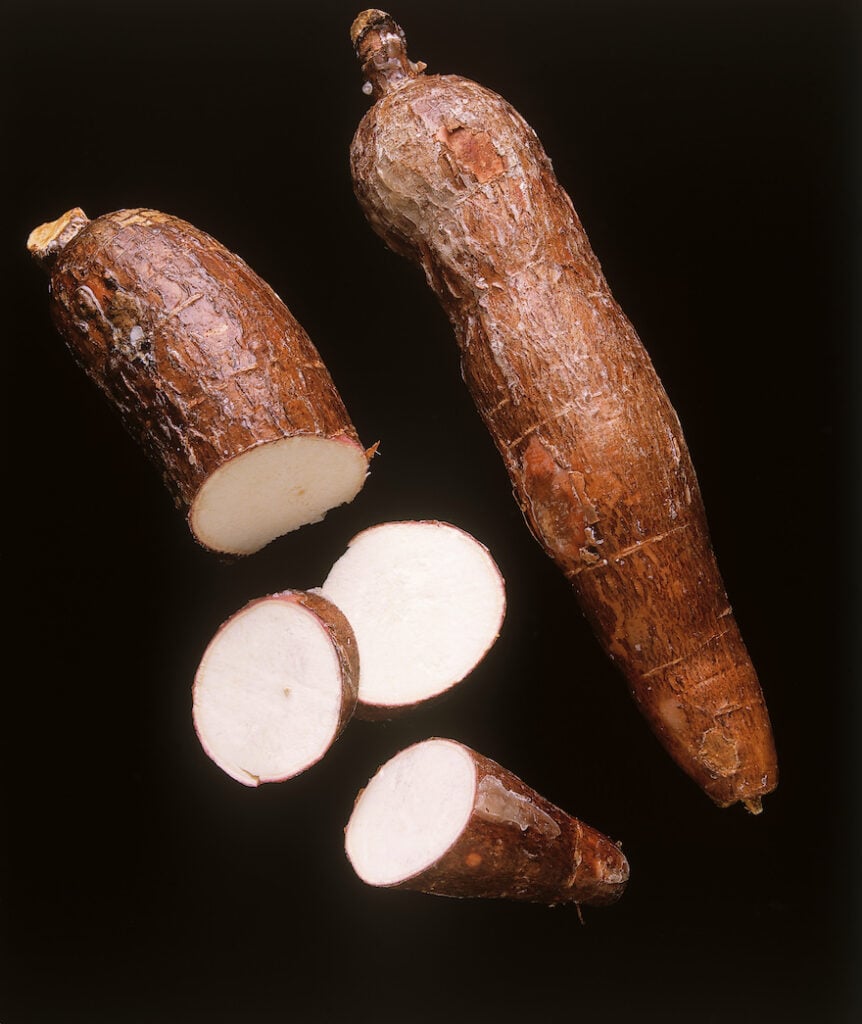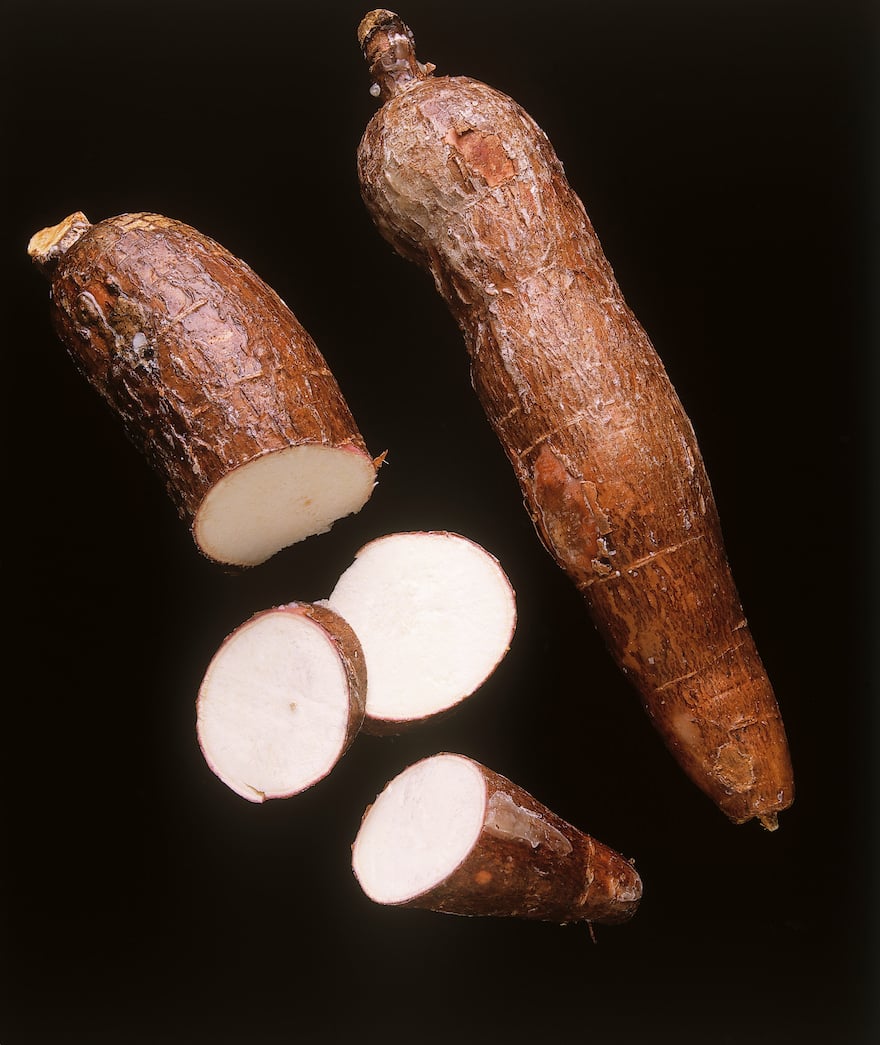I thought I should do an overview of cassava flour since I include it in so many recipes including Vegan Gluten Free Tortillas, Gluten-Free Gnocchi, Maple Walnut Oatmeal Cookies, and Crispy Gluten-Free Vegan Waffles. It’s a newer choice that’s catching on quickly because of the many benefits.
Overview
Cassava flour comes from the starchy tuberous root of the yuca plant (yoo-cuh). The flour ground from yuca root is a whole-food, plant-based, grain-free, gluten-free, and nut-free substitute for all-purpose wheat flour.
Not to be confused with the yucca plant, the yuca plant readily grows in tropical and sub-tropical climates. It is an important calorie-rich staple crop in many developing countries. It is also called manioc among other names.

How to Use Cassava Flour
Cassava flour is lighter than all-purpose flour. Be gentle when pouring or stirring since this powdery flour goes airborne easily. As with any flours/powders you do not want to inhale it; your lungs don’t enjoy being gummed up!
It makes a wonderful replacement for all-purpose flour when baking cookies, cakes, muffins, or brownies. It’s also perfect for making waffles, pancakes, crepes, and flatbread – anything that’s non-leavened. If making a yeast bread, find a recipe specifically designed around this ingredient, otherwise you’ll be disappointed.
By Dry Cup Measurement
You can use as a one-to-one replacement when measuring if you gently fluff up the flour first with a spoon. Do this while the flour is still in its package; be careful not to breathe it in. Don’t weigh the flour down when measuring, but rather spoon the fluffed up flour into the dry measuring cup (a cup meant for measuring flour and other dried goods versus liquids). Using the back of a straight knife, evenly scrape the excess flour from the cup.
If you prefer not to fluff it up, then use 25% less cassava than the recipe calls for. So for each cup of all-purpose flour, substitute with 3/4 cup of cassava flour scooped directly out of the bag using a dry measuring cup. Then use the back of a straight knife to evenly scrape the excess flour from the cup.
By Weight
Use as a one-to-one replacement by weight. A cup of all-purpose flour weighs about 120 grams, so for each cup of all-purpose flour in a recipe, substitute with 120 grams of cassava flour.
Combining Flours
I’ve also had very good results combining cassava with other flours such as oat, almond, garbanzo bean, and gluten-free flour blends.
Cassava flour vs tapioca flour
Cassava and tapioca both come from the yuca plant. However, there are differences – and I do not suggest using tapioca in place of cassava. Tapioca flour contains just the starch of the root, hence it is also called tapioca starch; it is often used as a thickener. Tapioca pearls are formed from this starch. Cassava flour, on the other hand, is made by drying and grinding the entire peeled root and is a whole food. Cassava flour behaves differently than tapioca, especially when baking.
Health benefits of cassava flour
- Considered an allergy-free food
- Low-fat
- Contains some vitamin C and B vitamins
- Some of the starch present in cassava flour is beneficial “resistant starch.” Resistant starches travel through the upper digestive tract unchanged, then feed beneficial gut bacteria in the large intestines. Studies show resistant starches reduce the risk for obesity, colon cancer, and type 2 diabetes. Legumes (beans and lentils) are also resistant starches.
Even still, please note that cassava is high in calories and carbs, plus fairly low in fiber – so it should be eaten in moderation. Consume with high-fiber protein-rich foods for a balanced meal.
Cassava flour brands
My local health food store and healthy market carry Otto’s Naturals brand cassava flour; it’s the only brand that I’ve tested so far. It isn’t organic but it is a reputable brand that is well tested to be sure it doesn’t contain any arsenic. Yuca will absorb any toxins present in the soil, so be sure to purchase from a reputable source.
I’ve read that not all cassava flour brands are alike, and many people report that Otto’s is the only one they approve of. Feel free to leave a comment below and let me know what your personal experience is on the topic.


Wow ! This post is so helpful. Really appreciate it. I have been experimenting making a nutritious version of Indian style Chapati or rotla (flatbread, traditionally made with wheat flour) using a combination of black millet flour ( RAGI flour), lentil flour and rice flour, water, salt and a little oil as well as cumin seed. I started adding an additional 1/4 CUP cassava flour to my dough after your recommendation in a tortilla recipe blog you posted earlier this year…. and now my Rotla flatbread are lighter in texture and PERFECT! thanks for sharing so many great useful tips.
Ahhhh that’s so good to hear Enilse. I’m glad I could help!
Wow, I’ve never used black millet flour or lentil flour, now you’ve piqued my interest. I still have so many flours to experiment and play with!
I’d love to see a photo of the Chapati you make.